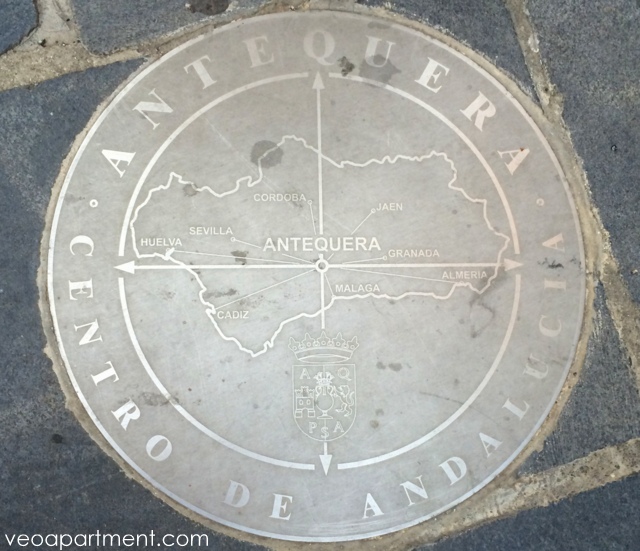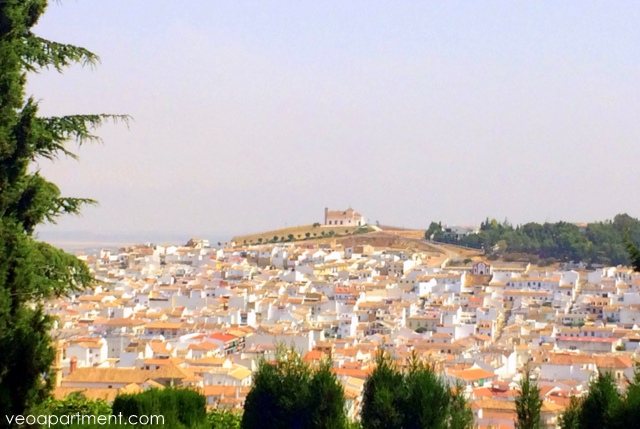Most of you will be familiar with the names of the major cities and tourist destinations of Andalucia, even if you have never been to them yourself – Seville, Granada, Cordoba, Malaga, and probably Cadiz, Ronda and Marbella. But this region of Spain is full of less well-known towns and cities with their own charm, place in history, culture and things to see and do. So hands up if you’ve heard of Antequera, and a gold star if you can point to it on the map.
 plaque in Plaza San Sebastian
plaque in Plaza San Sebastian
For the rest of you, Antequera is the small city that is officially the centre of Andalucia (there’s a plaque in the Plaza San Sebastian), owing much of its importance to being at the crossroads (and crossrailways) of Seville, Malaga, Granada and Cordoba. This means that it’s easy to get to from any of these places, either by car or by train, compact enough to see on a day trip, and interesting enough to be worthwhile making the effort.
Antequera’s most important monument and tourist attraction is undoubtedly the Alcazaba, the Moorish fortress built on a steep hill on the southern edge of the town in the 13th century to protect the city from the Christians. After the city was conquered by the Christians in 1410 it served a similar purpose, only in reverse. Take the audio guided tour to learn about the history of the site (which goes back to Roman times), which although a bit hokey, featuring the voice of the prince who led the Christian forces, is still a mine of interesting history and anecdote. One of my favourite things, though, was watching the city being gradually revealed below me as I climbed the winding streets that lead up to the fortress. The strangely shaped mountain that you can see from up here just outside the town is the Peña de Los Enamorados (Lovers’ Rock), where two young lovers from rival Moorish clans are supposed to have thrown themselves to their deaths while being pursued by the girl’s father.
 view of Antequera from the Alcazaba
view of Antequera from the Alcazaba
The other thing you’ll notice is the profusion of churches and other large religious and civil buildings (look especially for the Golden Angel on top of the tower of San Sebastian, which is more or less invisible from ground level) for which the city is rightly noted. Most of them date from the period of prosperity that followed the fall of Granada and the discovery of America by Columbus (both in 1492). We discovered that opening times for these seem to be rather limited and random, but on any walk through the town centre you’ll discover at least a couple that you can go into, enough to give you a taster.
You should also make a point of visiting the Antequera Museum, one of the largest in Andalucia, which covers every aspect of the history and culture of the town. Find it in the Palacio Najera in the Coso Viejo Square.
If you have a bit more time you might want to visit the dolmens (burial mounds) of Viera and Menga, which are around 4,000 years old, and the most ancient evidence for the presence of people in this part of Spain, and the nature reserve of El Torcal, famous for its unique limestone rock formations.
 three versions of porra at Arte de Cozina
three versions of porra at Arte de Cozina
Antequera is also the home of the mollete (a soft flat bread roll), and porra (a local variant of the more famous salmorejo). For a great breakfast of toasted molletes or churros try Cafe La Fuerza near the bullring. You can find good traditional tapas at Rincón de Lola near Plaza Coso Viejo, and 5sentidos (recently opened by former Lola chef) offers trendy tapas, including a spicy Bloody Mary with cockles. At Arte de Tapas and Arte de Cocina (tapas bar and restaurant respectively), the menus feature revivals of old recipes, some dating back to medieval times, and chef Charo Carmona will also give you the recipes for you to try them at home. The tasting menu at Arte de Cozina is spectacular but be sure to book ahead.